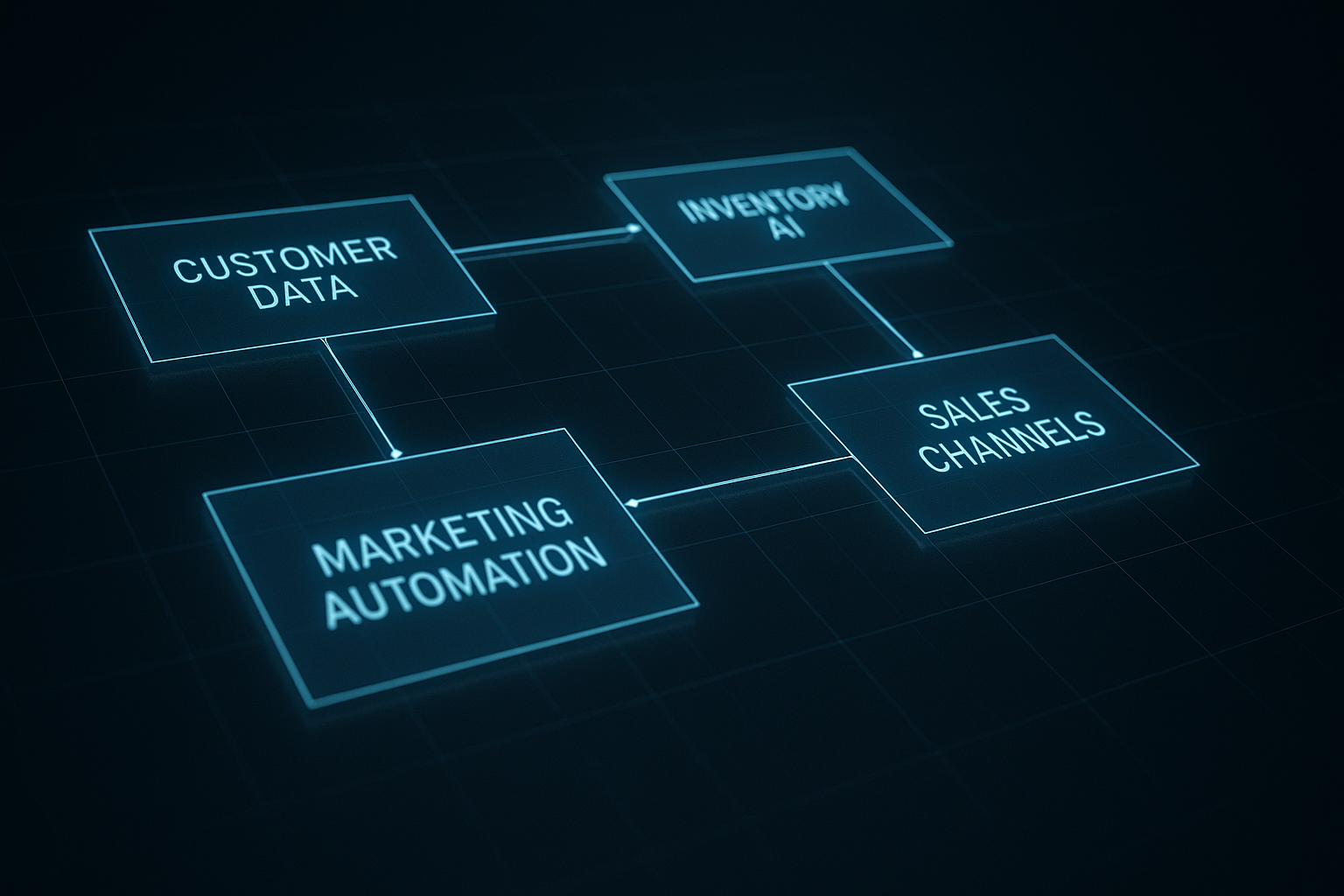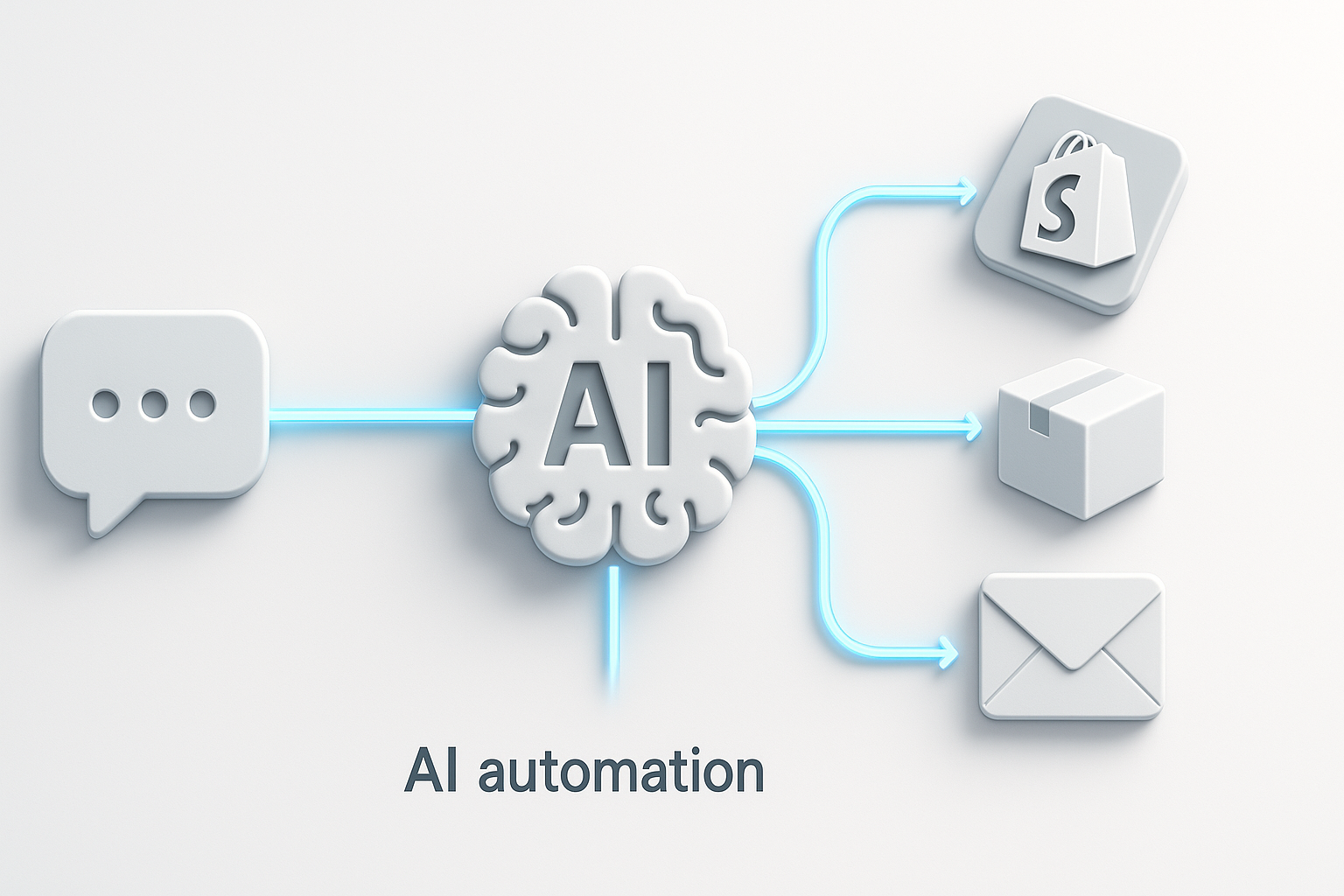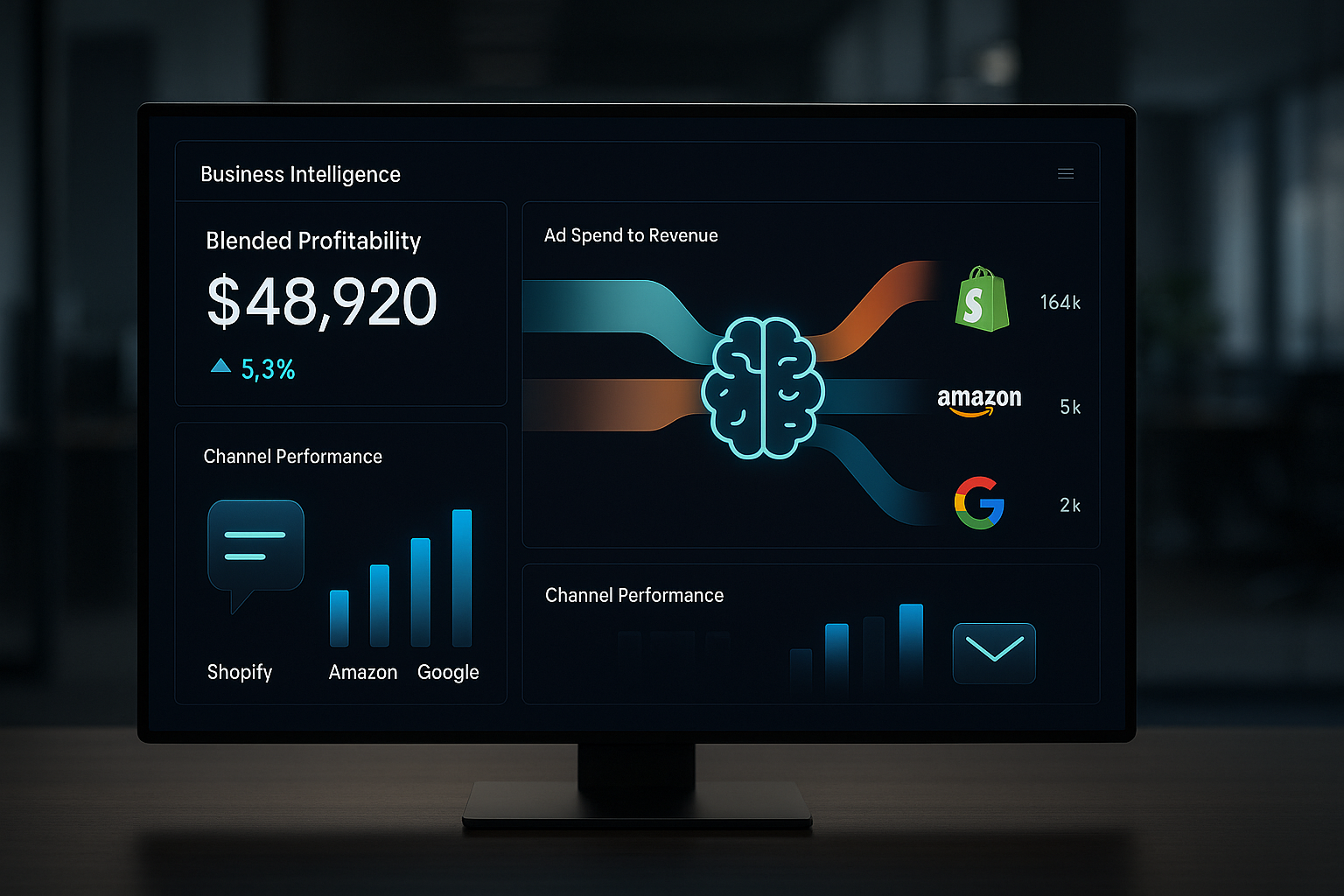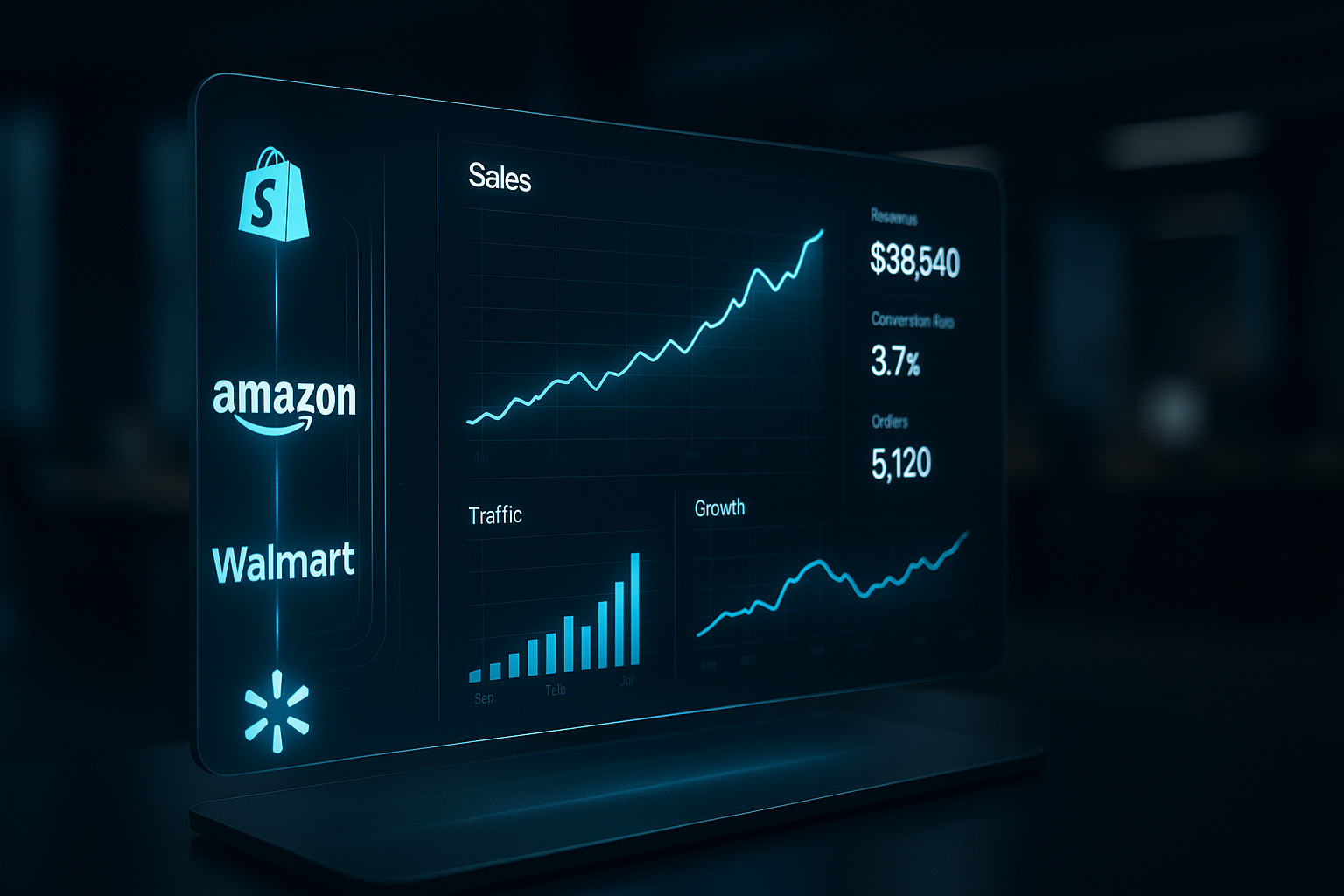An Engineer's Guide to AI & Automation: 4 Systems to Scale Your Ecommerce Business
By John, CTO at FND Automations
I’m currently a Master's student in Mechanical Engineering at MIT, and my studies have taught me one core principle: every complex system, whether it's an automated manufacturing line or an ecommerce business, lives or dies by its efficiency. Inefficiencies, what we engineers call "operational drag," are like friction—they waste energy, slow you down, and can lead to catastrophic failure if left unchecked.
As the technical lead at FND Automations, I see this drag plague ecommerce businesses every day. Founders are stuck in a loop of manual tasks, exporting CSVs, and making gut-feel decisions because their systems aren't integrated. They know AI is the answer, but they're rightfully skeptical of the vague promises.
This isn't another article about "the power of AI." Trust me, as someone who is surrounded by the space everyday, I get just as frustrated seeing article after article full of vague promises without any real substance. Half the time these articles are written by people who can't even articulate how the most basic of AI models actually functions. While I don't plan on boring you with the intricacies of the math behind the matrix multiplication and optimization functions that power neural nets, I can promise you that this article will not be one of those wastes of time. This is a practical, systems-level guide to four specific automation frameworks we build for our clients. I'll show you how these tools actually work together, so you can see the blueprint for yourself and begin to explore more areas of your business that are ready for automation. If you do have any questions about the article please feel free to email me using the provided contact info located on the About Us page of this website.

1. The Autonomous Support Agent: From Chatbot to Problem-Solver
The Business-Killing Flaw:
Your customer service is a critical system. A standard chatbot is like a faulty switch. It only works for the simplest inputs. I've lost track of how many times I've been frustrated by a website's simple chatbot that can only help you with the simplest of questions that could likely already be answered just by looking at their FAQs. Half these companies seem to have removed their standard support systems, leaving customers frustrated and lacking answers. In the ecommerce space, this is a direct way to drive customer loss. We aren't in the business of hacky quick-fix solutions that are copied across industries and applied with a standard template. Too many of our competitors with this approach have already given the AI space a bad name. You know that's not what your business needs and we know that's not the way to add value. Instead, we can implement a custom solution for your business using automation workflows and AI models directly connected to your core data. This approach allows for deeper company knowledge embedded into the model, meaning it can solve your customers' real issues, not just regurgitated FAQs.
The Integrated System:
Instead of just installing a standard chatbot, we build an intelligent system using powerful automation platforms that connect all your business tools together. Here’s a simple breakdown of how it works:
- First, the moment a customer starts a chat on your site, our automated system is listening.
- Next, their message is instantly analyzed by an AI to understand exactly what they need, whether it's a tracking update, a return request, or a question about a product.
- Finally, the system takes action automatically. If the customer wants their order status, the system connects directly to your Shopify store, finds their specific order, and provides a real-time tracking update right in the chat. If they need to make a return, it can instantly generate a shipping label and email it to them on the spot.
This system works tirelessly in the background. It solves the easy problems instantly so your human team can handle the tough questions that actually build customer loyalty.
The Real Business Cost of Weak Support
Slow or ineffective support doesn't just annoy customers; it actively costs you money. Here's how:
- Increased Cart Abandonment: If a customer has a pre-purchase question and can't get an instant answer, they won't wait. They'll just buy from a competitor.
- Wasted Payroll: Every hour your team spends answering "Where is my order?" is an hour they can't spend on high-value tasks like upselling, nurturing leads, or handling complex issues that save a customer relationship.
- Negative Reviews & Word of Mouth: A poor support experience is one of the fastest ways to get a 1-star review, which can deter hundreds of future customers.

2. The Predictive Inventory Engine: From Guesswork to Certainty
The Business-Killing Flaw:
Running your inventory based on last month's sales report isn't just outdated; it's a recipe for disaster. This isn't a theoretical problem. I saw it happen to a client firsthand. They were heading into a huge holiday weekend, but their star product went out of stock on a Friday afternoon because their forecast was based on old data.
The immediate damage was tens of thousands in lost sales over just three days. But the real cost, the one that truly hurts a growing brand, was the loss of opportunity. That wasn't just lost revenue; it was thousands of lost chances to create new loyal customers who will now likely remember buying from a competitor instead. That's the real danger of guesswork. You can't run a modern ecommerce brand by looking in the rearview mirror.
The Integrated System:
Instead of relying on guesswork, we build an intelligent system that acts as an early warning for your inventory. It works by:
- Automatically gathering key information from all corners of your business, including website traffic, current ad performance, and historical sales data.
- Using an AI to analyze all of this data together, creating a smart and accurate prediction of how much you will sell in the near future.
- Sending an automatic alert to your team the moment it determines a product is at risk of selling out, giving you plenty of time to reorder.
This turns inventory management from a stressful, reactive chore into a calm, data-driven process that protects your revenue and prevents costly stockouts.
How This Directly Impacts Your Bottom Line
Poor inventory management drains cash from your business in ways you might not even see. This system fixes those leaks:
- It Stops Wasted Ad Spend: There is nothing worse than spending money on ads that send traffic to a sold-out product page. This system helps prevent that by alerting you well in advance.
- It Protects Your Search & Marketplace Rank: Platforms like Amazon penalize sellers who frequently go out of stock. By maintaining inventory, you protect your ranking and organic sales.
- It Frees Up Your Cash: The flip side of stockouts is overstock. Having cash tied up in products that aren't selling is a massive drag on growth. A predictive engine keeps your inventory lean and your cash available for new opportunities.
3. The "Mission Control" Dashboard: From Data Chaos to a Single Source of Truth
The Business-Killing Flaw:
It's impossible to make good decisions when your data is a mess. I've seen some extreme examples of this, but one recent client stands out. They had a dedicated team member whose main job was to manually enter every single purchase, every single day, into a massive Google Sheet. It was a monumental waste of time and talent.
The craziest part wasn't even the spreadsheet itself. It was that they had already tried multiple "out-of-the-box" ecommerce analytics tools, but none of them worked. These tools are built for the 'average' business, and they completely failed to meet this client's specific needs. A one-size-fits-all solution rarely fits anyone perfectly, and it was actively holding their business back.
That's exactly where we come in. We built them a system that automatically pulled all their data together, and then created a fully custom dashboard that showed them the real numbers they actually needed to run their business. They went from wasting hours on manual data entry to making strategic decisions in minutes, all based on live, accurate information.
The Integrated System:
The solution to data chaos is to build a single, reliable "mission control" dashboard for your entire business. Here’s how our system delivers that clarity:
- It automatically works 24/7 in the background, connecting to all your sales and marketing platforms like Shopify, Amazon, Facebook Ads, and Google.
- It pulls all your key numbers—sales, ad spend, fees, and shipping costs—into one central, organized hub, so nothing gets missed.
- All this information is then displayed on a single, easy-to-read screen. For the first time, you can see your true, up-to-the-minute profitability across your entire operation.
This gives you the clarity to make smart decisions fast. A client of ours used this exact dashboard to spot an unprofitable product and boost their overall margin by 15%—an insight that was impossible to find when their data was a mess.
The Critical Questions This Dashboard Finally Answers
A unified dashboard moves you from guessing to knowing. For the first time, you can get concrete answers to the most important questions in your business:
- What is my true, blended Profit After Ad Spend (POAS) across all channels, right now?
- Which specific products are actually losing me money after all fees and shipping costs are factored in?
- Which marketing channel (Google, Facebook, TikTok) is bringing in the most profitable customers, not just the most sales?
- What is the real lifetime value of a customer from each channel?
Answering these questions is the key to unlocking scalable, profitable growth.

4. The Hyper-Personalization Engine: From Generic Blasts to 1:1 Marketing
The Business-Killing Flaw:
Sending the same marketing email to every single person on your list is a massive waste of time and money. This inefficiency is everywhere. I just talked to a marketing lead at an ecommerce brand last week who spends more than five hours writing and formatting every single blog post. That's valuable time that could be spent on high-level strategy—tasks that only a leader or manager can do.
In today's world, your competitors are doing everything they can to streamline their companies and run the leanest business possible. While you're spending hours on manual work, they are using automation to move faster. If you accept inefficiency, you will lose your competitive edge by the end of the year. We spend our lives in the AI space and through our work with clients, we know the revolution marketing is going through. Those who don't adapt will be left behind.
Outreach now needs to be rapid and adaptable while providing real value. People are tired of generic ads; it's all just noise. The only way to win is to be relevant. You have to talk to your customers like you actually know them—and with the right data, you finally can.
The Integrated System:
We build smart marketing systems that react to your customers' behavior, allowing you to talk to them like you actually know them. A great example is our "Smart Abandoned Cart" system:
- Our automated system sees the moment a customer leaves your site with items still in their cart.
- It instantly checks to see if this is a brand new visitor or one of your loyal VIP customers.
- An AI then writes a perfectly tailored follow-up email on the spot. A new customer might get a friendly reminder, while a VIP could receive a personal thank-you note with a special discount code.
This simple but powerful automation turns a generic reminder into a personal touchpoint that makes customers feel valued and significantly increases your chances of recovering the sale.
How Personalization Creates Long-Term Value
This isn't just about a one-time sale recovery. A smart personalization engine builds the foundation of a powerful brand by:
- Increasing Customer Lifetime Value (LTV): Making customers feel seen and valued turns them from one-time buyers into repeat purchasers who are excited to hear from you.
- Improving Email Deliverability & Engagement: When your emails are consistently relevant, open rates and click-through rates soar. This improves your sender reputation, ensuring more of your emails land in the inbox, not the spam folder.
- Creating a Competitive Moat: Any competitor can sell a similar product. But few can replicate a deeply personal and responsive customer experience. This becomes your unique advantage.
From Blueprints to a Fully-Functioning Engine
As you can see, real automation isn't about finding one magic tool. It's about thinking like an engineer. It's about designing smart systems that connect your tools together to eliminate wasted effort and give you the data you need to grow.
Building these systems is what we do. If you're ready to stop putting out fires and start building a more efficient business, then let's talk. I invite you to schedule a no-cost systems consultation with our team. This won't be a sales pitch. It will be a real conversation where we dig into your specific business challenges, just like we've done in this article.
Let's architect your growth.
